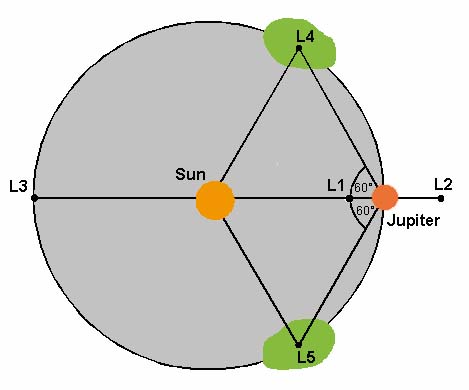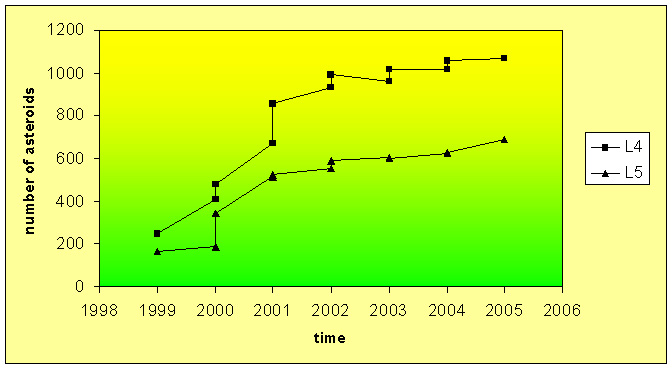
Trojan Asteroids | ||
|
In 1772 Joseph Lagrange discovered five special points in the vicinity of two orbiting masses where a third, much smaller mass can orbit at a fixed distance from the larger masses. More precisely, the equilibrium points - also called Lagrangian points - mark positions where the gravitational pull of the two large masses precisely equals the centripetal force required to rotate with them. The Lagrangian points are the five stationary solutions of the restricted three-body problem, as it is demonstrated in figure 1. L1 through L3 are points of unstable equilibrium; any disturbance will move a test particle there out of the Lagrange point. That is, because a small perturbation will cause the third body to drift away. Only L4 and L5 are stable and located at the apex of equilateral triangles with the massive bodies at the vertices (Figure 1.) Objects orbiting around L4 and L5 are stable because the Coriolis force keeps them spinning around the Lagrange point. In February 1906 Max Wolf (1863-1932) discovered the first Trojan asteroid near the planet Jupiter and named it Achilles (588) after the mythical Achilles, one of the heroes of Homer's Iliad.  Figure 1: L1, L2 and L3 lie on a straight line connecting to the (not stable) other bodies L4 and L5 (stable for mue < 1:25 (mue=mass ratio between Sun and Jupiter) are at the third vertex of an equilateral triangle (Sun-Jupiter-Asteroid) Nowadays (16. June 2005), 1088 asteroids at the equilibrium point L4 and 699 asteroids around L5 are known. Thus, the question arises why are more Jupiter are more Trojans found around L4? I want to confirm whether L4 is really more stable than L5 and I want to determine the condition for this behaviour. Figure 2. shows the number of investigated Trojans for both Lagrangian points for the last two years. It is remarkable that the difference between L4 and L5 is constant. So one can infer that the difference is not an observational effect! A dynamical difference between L4 and L5 were found, but further investigations have to be done.  Figure 2: Number of Jupiter Trojans: the upper line represents L4 and the lower L5. |